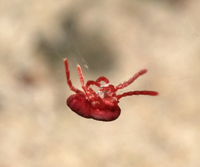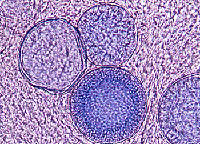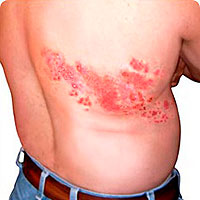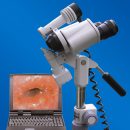Abdominal title - acute, inherent in human disease related to intestinal infections, and caused by bastyphoundic bacteria Salmonella Typhi.
Content
Historical reference
The typhoid appearance was first described in detail in 1643 tons.Willisia. Due to the similarity of the symptoms of the abdominal and suction typhus, these diseases were not distinguished for a long time until in 1837.Gerhard did not describe their clinical features, determining the abdominal typhus as «tyifoid» Forab. The infectious nature of the abdominal typhoid and the possibility of infection through the patient's feces was installed at.Badd as a result of epidemiological studies in 1856. Later, in 1880, to.Ebert opened the causative agents of the abdominal typhoid - Tiffoid bacillos (row-shaped bacteria). High mortality from abdominal typhus during the Spanish-American and Anglo-Board Wars confirmed the urgent need to create a preventive vaccine, which was soon developed (COLL, PFFIFER, Wright, Russell). In early 20. The incidence of abdominal typhoid decreased sharply in countries where sanitary and hygienic measures began to combat intestinal infections.
How is the infection of abdominal tiff
Currently, the main source of typhoid infection worldwide is chronic bacteria carriers. Together with the excrement (Call), causative agents of the disease fall into the external environment and distributed through water, milk, food products. One patient or carrier can be a source of infection of large populations. Possible transmission of infection through unmeed fruits and vegetables or raw mollusks; carriers can be flies. Frequently found to 1910 large-scale summer outbreaks of abdominal typhoid (due to the only case of the disease and the spread of infection through water) practically disappeared as a result of sanitary measures.
Driving pathogen in our body
Infection of abdominal title occurs with food or water. Bacteria penetrate Peyer plaque (clusters of lymphoid tissue) lower intestinal departments and multiply in them. From there they enter the bloodstream, that is, bacteremia develops with which the beginning of the fevering period is coincided (temperature increase). From the moment of infection until the temperature increases, approximately 10 days. Characteristic signs of inflammation are found in all lymphoid tissues of the body, including a spleen.
Symptoms of abdominal typhoid
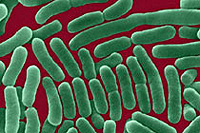 The disease begins with general malaise, headaches, pain in the whole body, loss of appetite during the first week and gradual increase in temperature up to 40°. High temperature is saved for 1-2 weeks, with daily oscillations about 1°. In case of recovery, after another 1-2 weeks, the temperature gradually returns to normal. Usually during the first week on the skin of the abdomen and the bottom of the breast, the patients appear characteristic rash in the form of small pink specks. Pulse is weak, despite the fever. The amount of white blood cells reduced (leukopenia).
The disease begins with general malaise, headaches, pain in the whole body, loss of appetite during the first week and gradual increase in temperature up to 40°. High temperature is saved for 1-2 weeks, with daily oscillations about 1°. In case of recovery, after another 1-2 weeks, the temperature gradually returns to normal. Usually during the first week on the skin of the abdomen and the bottom of the breast, the patients appear characteristic rash in the form of small pink specks. Pulse is weak, despite the fever. The amount of white blood cells reduced (leukopenia).
Because of the pronounced meteorism, the belly will be taken, painful in palpation. Constipation alternate with the attacks of a liquid chair in the form «pea soup». Language is thickened, covered with a gray brown bloom, carrying teeth prints. Possible nasal bleeding and bronchitis. At the height of the fever, there is a sharp weakness, a violation of consciousness with alternating the delusional state and the full loss of activity.
Unconditional confirmation of the disease is the allocation of abdominal bacilli (bacteria - sticks) from the blood (during the first week of the disease) or from urine and feces - in the second week. The second week becomes a positive Vidal reaction, t.E. Bonding (agglutination) of abdominet phonic tube serum patient. According to the diagnostic value, the Vidal reaction is inferior, however, the test for the seducing agent is.
The complications of the abdominal typhoid include hemorrhages in the intestinal wall and other organs, campaign (breakthrough of the resulting ulcer) intestines, pneumonia, thrombosis. Quite often, repeated attacks of the disease occur, but, as a rule, they proceed in easier form.
Treatment of abdominal typhoid
Insulating the disease in combination with good care and timely treatment with antibiotics led to a 10-fold reduction in mortality among patients (up to 1% or less). The most effective means of treatment - antibiotic chloramphenicol (Levomycetin). Splitting intestinal requires immediate surgery.
Persons traveling to areas with high morbus typhoids, vaccination is recommended, as well as everyone living in infection foci. Distinguish live oral vaccine (taking through the mouth) and a vaccine containing killed bacteria (injected intramuscularly). When applied, immunity is developing in 2-3 weeks and is preserved at least for 3 years. Vaccine Apply from 5 years, vaccinations for children 2-5 years have been held after consulting a doctor. Contraindications are allergic reactions to compensative vaccine.



